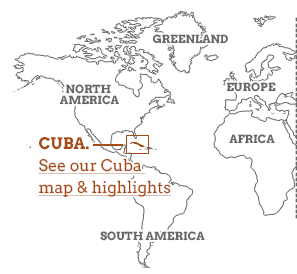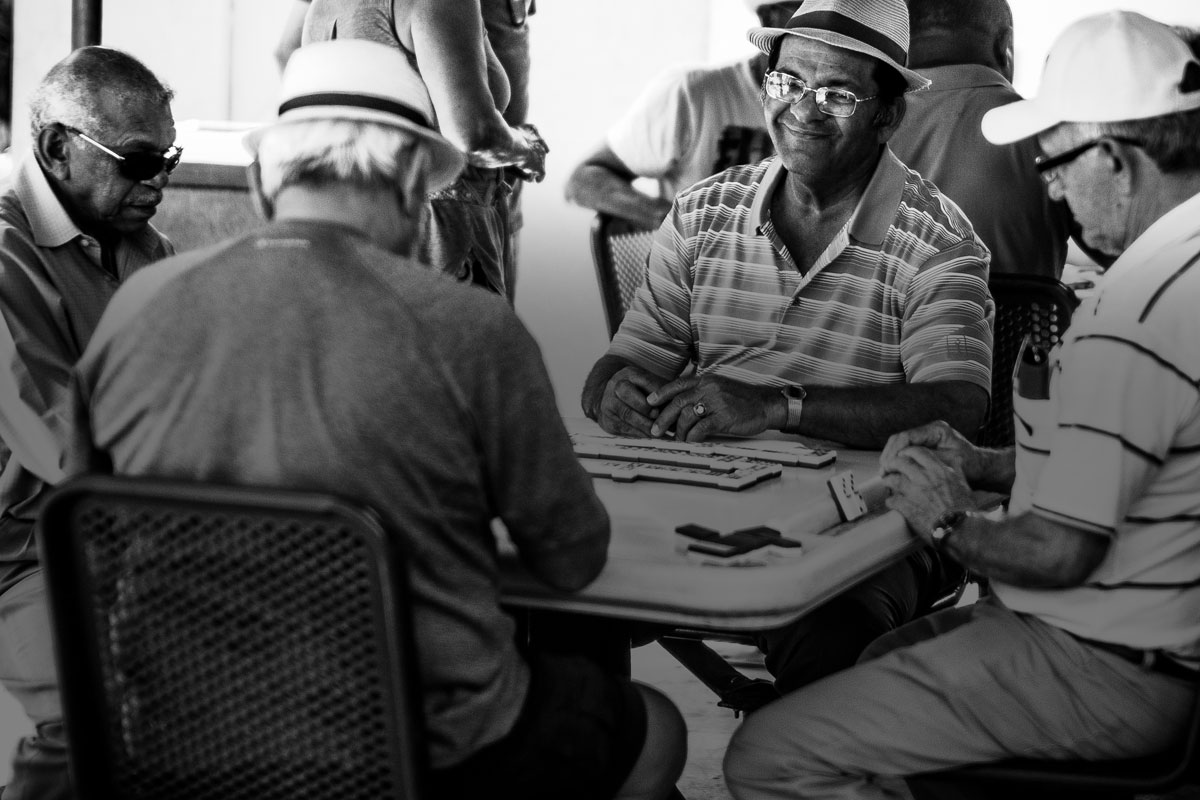Cuba travel guide

Stepping into Havana for the first time is a world of classic cars, crackling transistor radios and clacking dominoes. As you meander into the countryside, cowboy-hatted farmers ride horses through the forests, and oxen plough the fields, wheelbarrows spill over with homegrown veg and rocking chair-bound residents sip rum on the porch.

Almost six decades of communism may have stripped Cuba of much of its material wealth; the ration system leaves many hungry and shops echo in their emptiness. But the country's cultural riches - from salsa to ballet, jazz to the percussion of the Afro-Cuban religions - have been preserved. Even as the US slowly breaks down the virtual wall it has created around Cuba and tourist numbers increase, it still continues to pulse with its own unique beat.

Few nations have the romanticised history of Cuba; a beautiful tropical island that fought its way out of capitalism led by charismatic comrades.![]()

Cuba is still a Caribbean island, and the beaches and bays are a vacation must. Just don't make the mistake of thinking this is all there is – as our Cuba travel guide reveals, there's a whole world beyond the resorts.
Cuba is/isn't
Cuba is...
the home of tropical communism. It is one of only four communist states, with China, Laos and Vietnam.
Cuba isn't...
easy to understand. If you come here with preconceived ideas, you'll leave more confused than ever.
10 day Cuba tour, small group
Group tour exploring the beguiling and captivating Cuba
From
€840 to €1325
10 days
ex flights
Self drive Cuba family vacation
Family vacation Cuba for parents & children
From
€1450
15 days
ex flights
Cuba cultural vacations, 15 days
Fun and legal way to experience Cuba's diversity
From
US $2390
15 days
ex flights
One week tour of Cuba
Discover the history, culture and natural beauty of Cuba.
From
US $1200 to US $1900
7 days
ex flights
What we rate & what we don't
Underrated
Nature & national parks
Cuba's culture is widely enjoyed, yet nature fans should not dismiss the Caribbean's largest isle. 19 percent of Cuba's land is protected, and two of its nine UNESCO sites are natural, protecting marine limestone terraces and montane forests. There are endemic birds and orchids, hikes through the dramatic scenery of the Sierra Maestra and superb diving, without the tourist hordes of better known nature destinations.
Baracoa
One of Cuba's most overlooked spots, this little seaside town gives way to some of Cuba's most dramatic landscapes: river filled rainforests, towering mountains, glorious waterfalls and the flat topped El Yunque mountain, which is ideal for hiking. Baracoa's unique character has been preserved by its geographical isolation; until the 1960s it was only accessible by boat.
Santiago de Cuba
Squeezed between the mountains and the Caribbean Sea, Santiago has Cuba's hottest climate – and a proudly rebellious history. Explore Afro-Haitian culture, a well-worn city center, and a different band for every doorstep, street corner and plaza. The bullet-riddled Moncada Barracks are a legacy to the revolution that never happened here.
Planning ahead
If you're looking for a last minute break, Cuba may not be the place for you. With travel here easier for US citizens, tourism is booming, for better or worse. Rooms and rental cars book up months in advance, especially between Christmas and Easter - so get ahead of the game.
Rated
Havana
Habana Vieja - Old Havana - is pretty much everything you dreamed it would be. While other historical centers have become victims of ther own success, gentrification has not penetrated this communist capital, and the 1950s cars, streetside salsa and crumbling colonial casas mean you will never have your finger far from your camera shutter.
Music & dance
Salsa, son, rumba, jazz... Cuba's cobbled streets echo with the sound of some of the world's most seductive music. You'd pay a fortune to see musicians this good elsewhere; here, it'll cost you a few pesos as a tip, and they even take requests. Take salsa classes here and learn with the best, watch a performance by the National Ballet, get serenaded in El Floridita, or join one of the many festivals and carnivals that take place throughout the year.
Home stays
The original Airbnb, since 1997 Cubans have been allowed to open their homes to guests, in a system known as casas particulares. Most also open their hearts and minds, giving a glimpse into the realities of Cuban life, as you sip coffee or tuck into a homecooked breakfast with your hosts. This is also the best way to get insider tips on where to go.
Western Cuba
The limestone karst filled Valle de Viñales is a UNESCO World Heritage Site, and within this mountain-ringed landscape there are tobacco farms, oxen-ploughed fields; quaint villages and a way of life that has changed little in centuries. Explore the caves, ride horseback through the hills or sip an ice-cold Bucanero beer in the plaza as live music echoes off the colonial buildings.
Overrated
Varadero
Yes, it's a Caribbean island, and yes, some of its most stunning beaches are found around Varadero. But all inclusive resorts are to Cuba what Cancún is to Mexico or Benidorm is to Spain. Cuba's true beauty is its people and culture, and there are scant chances to encounter either of those here. Plus, the benefit to the wellbeing of the struggling locals is questionable.
Critiquing the cuisine
There’s a lot to discover about Cuban culture and history from its cuisine. Stick to casa cooking (in homestays) and paladares (private restaurants), rather than state-owned premises and hotel buffets, to enjoy great food and hear about the stories behind the ingredients and recipes. Havana is a great shout too, with new restaurants and top-class cocktail bars popping up all over the place.
Hotel stars
Cuban hotels are state run, and aside from the most exclusive, they are fairly shabby affairs; the general advice is to “remove one star” for a true reflection of facilities. The food is also uninspiring; we advise casas particulares (guesthouses) and paladares (privately owned restaurants) all the way.
Endless advertisements
In Cuba, advertising space is largely reserved for the communist party; the only billboards promote Che Guevara and Fidel Castro. Most souvenirs you pick up here will be unbranded (handmade musical instruments and clothing, hand rolled cigars) - save, perhaps, the odd, cheap bottle of Havana Club or Habanos cigar.
Food, shopping & people
Eating & drinking in Cuba
Coppelia ice-cream is a national institution. Queues trail in the heat for a couple of hours every day – but apparently it’s worth it!
Cuban fresh fruit is something to look forward to every morning. Don't just stick to what you know; try pink-fleshed guava, sweet chirimoya and avocado-like mamey.
Seafood is exceptional here; lobster is cheap and abundant - ask your casa hosts if they can prepare it for you.
Guava jelly is a sweet accompaniment to fresh bread and cheese.
People & language
"Yuma" means foreigner. It's the Cuban version of "gringo"
The Taino indians disappeared centuries ago, and modern Cuba is a Brazil-type blend of Latin and Afrocaribbean cultures. The east is the Afro-Cuban hub - come here for son music, rumba dance and the syncretic santeria religion. All Cubans speak Spanish, but many letters are dropped and there is plenty of local slang, making it tricky to grasp. However, any attempts to speak cubano will be much appreciated.
Black beans and rice
is known as
"moros y cristianos" - Moors and Christians
is known as
"moros y cristianos" - Moors and Christians
The cigar, in its home country, is known as a "puro"


Despite Cuba’s rifts with the US, its most popular sport is baseball. However, you’d be forgiven for thinking it was dominoes, which is played on every street corner.
![]()

Our top trip
Cuba salsa dance vacation
Learn to salsa in Santiago de Cuba
From
£1875 to £1975
15 days
ex flights
Small group travel:
2023: 26 Nov, 15 Dec
2024: 14 Jan, 11 Feb, 8 Mar, 28 Apr, 30 Jun, 24 Nov, 15 Dec
2023: 26 Nov, 15 Dec
2024: 14 Jan, 11 Feb, 8 Mar, 28 Apr, 30 Jun, 24 Nov, 15 Dec
Travel Team
If you'd like to chat about Cuba or need help finding a vacation to suit you we're very happy to help.
1-866-821-6866
Call toll free
Calling from outside the USA
Gifts & shopping
Decades of trade embargoes and an anti-capitalist mindset mean most of Cuba’s department stores lie empty. However, What it lacks in manufactured goods, it makes up for in homegrown skill.
Bring the sounds of Cuba home with you! Buy handcrafted musical instruments, such as guiras (made from gourds), claves (pairs of wooden sticks) and maracas – the shopkeeper will likely give you an impromptu percussion lesson.
The government’s emphasis on culture means artists’ studios abound, particularly in Old Havana and the eco-village of Las Terrazas. Paintings, prints and sketches capture the colours of Cuba, and make a unique souvenir.

An entire generation of Cubans grew up without Christmas. It was banned as a public vacation following the revolution and was only reintroduced in 1997.
![]()

How much does it cost?
Room in a casa particular: £15
Coppelia ice cream: 2p a scoop
Dinner in a casa: £5.95
A daiquiri in La Floridita: £3.90, with free banana chips
Roll of 10 cigars from a tobacco farmer: £14.80
Entry to the Museum of the Revolution: £4.20
Entry to the Museum of the Revolution: £4.20
A brief history of Cuba
Few nations have such a romantic history as that of Cuba, and despite the current frustrations with poverty, ration books and the crumbling casas, you can still sense the locals swelling with pride when they talk about the La Revolución.Read more







































